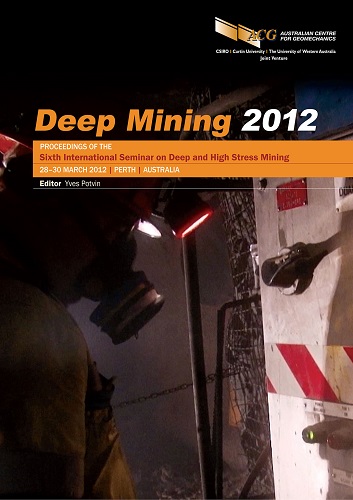Beyond coloured balls ‒ making sense of large volumes of microseismic data with diverse source mechanisms

|
Authors: de Beer, W; Ardito, JA; Mercier, J-P; Falmagne, V |
DOI https://doi.org/10.36487/ACG_rep/1201_10_debeer
Cite As:
de Beer, W, Ardito, JA, Mercier, J-P & Falmagne, V 2012, 'Beyond coloured balls ‒ making sense of large volumes of microseismic data with diverse source mechanisms', in Y Potvin (ed.), Deep Mining 2012: Proceedings of the Sixth International Seminar on Deep and High Stress Mining, Australian Centre for Geomechanics, Perth, pp. 149-159, https://doi.org/10.36487/ACG_rep/1201_10_debeer
Abstract:
The central theme of this analysis is the study of seismic response of the rock mass before and after the occurrence of a moment magnitude 2.0 seismic event that occurred in December 2010 at the San Rafael Mine sublevel open stoping operation located in Peru. A microseismic data set acquired by the mine microseismic monitoring system is analysed using a range of methodologies, including passive source tomography imaging, focal mechanism inversion, as well as deterministic and probabilistic approaches. P- and S-wave velocity models, calculated for three time periods, using a passive source tomography algorithm developed by Advanced GeoScience Imaging Solutions (AGSIS), was applied to the data set to image the evolution of the rock mass. The models show variations in the seismic velocity before and after the event that may relate to the distribution and redistribution of stresses in the rock mass. Probable focal mechanisms, exploration of the spatial geometry of seismic event distributions (using singular value decomposition and clustering) as well as rapid separation of populations of events which are generated by different source mechanisms were also used to illuminate different aspects of the seismic response to mining at that time. We note that the separation of populations serves only to provide consistent and unique distributions to use in the assessment of hazard due to particular types of activity. The complete dataset (with the possible exception of blasts and ore pass noise) is required for modelling velocity structures and understanding stress transfer mechanisms in the rock mass.
References:
Angus, D.A., Verdon, J.P., Fisher, Q.J. and Kendall, J-M. (2009) Exploring trends in microcrack properties of sedimentary rocks: An audit of dry-core velocity-stress measurements, Geophysics, Vol. 74, No. 5 (September–October 2009), pp. E293–E203.
Ben-Zion, Y. (2008) Collective behaviour of earthquakes and faults: Continuum-discrete transitions, progressive evolutionary changes, and different dynamic regimes, Reviews of Geophysics, Vol. 46, RG4006, .
Guéguen, Y., Sarout, J., Fortin, J. and Schubnel, A. (2009) Cracks in porous rocks: Tiny defects, strong effects, The Leading Edge, January 2009, pp. 40–47.
Hudyma, M.R. (2008) Analysis and interpretation of clusters of seismic events in mines, PhD thesis, Department of Civil and Resource Engineering, The University of Western Australia, November 2008, pp. 73–90.
Körmendi, A., Bodoky, T., Hermann, L., Dianiska, L. and Kàlmàn, T. (1986) Seismic measurements for safety in mines, Geophysical Prospecting, Vol. 34, pp. 1022–1037.
Richardson, E. and Jordan, T.H. (2002) Seismicity in Deep Gold Mines of South Africa: Implications for Tectonic Earthquakes, Bulletin of the Seismological Society of America, Vol. 92(5), pp. 1766–1782.
Trifu, C-I., Urbancic, T.I. and Young, R.P. (1993) Non-similar frequency-magnitude distribution for m < 1 seismicity, Geophysical Research Letters, Vol. 20, pp. 427–430.
© Copyright 2025, Australian Centre for Geomechanics (ACG), The University of Western Australia. All rights reserved.
View copyright/legal information
Please direct any queries or error reports to repository-acg@uwa.edu.au
View copyright/legal information
Please direct any queries or error reports to repository-acg@uwa.edu.au